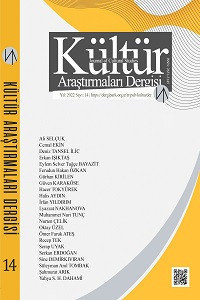Hayvanlara ve Bitkilere Tapmak
İnsanlığın ilkel yaşayışına saygı duyan çok az gelenek bulunmaktadır. Bu geleneklerden Sanchoniatho tarafından korunanlardan daha fazla dikkat çeken olmamakla birlikte belki de hiçbiri onlar kadar eski değildir. Onlar bize, modern araştırmaların sonucunun mükemmel bir şekilde doğru olmasıyla, dini spekülasyondaki insanlığın ilerlemesinin önceki aşamalarının bir taslağını sunar. Bu çalışmamızda yukarıda belirtilen evrim aşamalarını az çok yakından görmüş olacağız. Çalışmamızın konusu totemler ve totem tanrıları ya da genel anlamda hayvan ve bitki tanrıları ve bunların devamıdır. İlk olarak totemin ne olduğunu ve onlarla genel olarak ilişkilendirilen unsurları ayrıntılı biçimde açıklayacağız. Onların mevcut insan kabileleri arasında ne kadar ilerlediğini ve yakın zamanda sahip olduklarını göstererek, totem aşaması diyebileceğimiz dönemdeki insanların zihinsel durumuna elimizden geldiğince ışık tutacağız. Daha sonra tarih öncesi çağlardaki -antik- milletlerin totem aşamasından geçerek; hayvanlara, bitkilere ve hayvan olarak tasarlanan gök cisimlerine inanmalarını ve bunun delillerini; antropomorfik tanrılardan önceki tanrıları ve bununla ilgili açıklamaları dikkate alarak inceleyeceğiz. Bu çalışmada ulaşacağımız sonuç; antik milletlerin totem aşamasından geçmesi üzerine herkesi tatmin edecek bir varsayım olacaktır.
The Worship of Animals and Plants
There are very few traditions that respect the primitive way of life of humanity. Of these traditions, none are more noteworthy than those preserved by the Sanchoniatho, though perhaps none quite as old. They provide us with a sketch of earlier stages of human progress in religious speculation, with the conclusion of modern research being perfectly correct. In this study, we will be able to see the evolutionary stages mentioned above more or less closely. The subject of our study is totems and totem gods or animal and plant gods in general and their continuation. First, we will explain in detail what a totem is and the elements generally associated with it. By showing how far they have advanced among the existing human tribes and their recent possessions, we shall shed as much light as we can on the mental state of people in what we might call the totem stage. Then, passing through the totem stage of the -ancient- nations in prehistoric times; their belief in animals, plants and celestial bodies designed as animals and their proofs; We will examine the gods before the anthropomorphic gods and their explanations. The result we will reach in this study; Once the ancient nations pass through the totem stage, there will be an assumption that will satisfy everyone.
___
- Boudin, Marc (1864). Etudes Anthropologiques. Paris: Rue Childebert.
- Brett, William Henry (1868). Indian Tribes of Guians, Vol.VI. London: Bell and Daldy.
- Bryant, Jacob (1767). Observation and Inquiris. Cambridge: University.
- Bryant, Jacob (1774). Ancient Mythology, Vol.1. London: T. Payne.
- Cooper, James Fenimore (1826). The Last of the Mohicans: A Narrative of 1757. Paris: W. Galignani.
- Deanne, Bathurst (1830). The Worship of the Serpent. London: J. G. & F. Rivington.
- Evans, John (1832). British Coins. London.
- Ezekiel, von Spanheim Freiherr (1664). Numismata. London.
- Fergusson, James (1847). Tree and Serpent Worship. London: India Museum.
- Gallatin, Albert (1820). Archaeologia Americana. Chapter 2: Transactions and Collections of the American Antiquarian Society. Massachusetts: AAS.
- Grey, George (1840). Vocabulary of the Dialects of South-Western Australia. London: T & W Boone.
- Grey, George (1841). Travels in North Western and Western Australia. London: T & W Boone.
- Grey, George (1854). Polynesian Mythology & Ancient Traditional History of the New Zealanders. London: John Murray.
- Juvenal (1782). Satires. Paris: Imp. Libraires.
- Khatib al-Tibrîzî (1851). Mishkat al-Masabih. al-Dihlawi [Delhi]: al-Matba al-Ahmadi.
- Lavard, Nineveh (1856). A Popular Account of Discoveries at Nineveh. Vol.2. New York: Derby & Jackson. Long, John (1791). Long’s Voyages, Vol.1. London: SFS.
- Muir, John (1873). Sanskrit Texts. Chapter IV. London: Trübner.
- Müller, Max F. (1869). Rig-Veda-Sanhita: The Sacred Hymns of the Brahmans, Vol.1. London: Trübner and Co.
- Ovidius (1845). Metamorphoses 1, 6. London: Marshall Jones Company.
- Pausanias (1583). Tes Hellados Periegesis. Lipsiae: ATF.
- Prescott, William Henry (1847). A History of the Conquest of Peru, Vol.12. New York: Harper & Brothers.
- Sanchoniatho (1720). Phoenician History. London: W. B. R. Wilkin.
- Speke, John Hanning (1863). Journal of the Discovery of the Source of the Nile. New York: Harper & Brothers.
- Valikhanov, Chokan C. (1865). The Russians in Central Asia. Trans. Messrs Michael. L. London: Edward Stanford.
- Williams, Thomas (1858). Fiji and the Fijians, Vol.1. London: Alexander Heylin.
- ISSN: 2651-3145
- Yayın Aralığı: Yılda 4 Sayı
- Başlangıç: 2018
- Yayıncı: Mehmet Ali YOLCU
Sayıdaki Diğer Makaleler
Tanzimat Romanındaki Batılılaşma Krizine Dair Bir İnceleme
Mektup Türüne Yeni Bir Bakış: Tanzimat Dönemi Mektuplarında Kaygı ve Endişe
Fatemeh BADEL, Hicran Hanım HALAÇ
Baudrillard’ın Foucault Eleştirisinde Özne Sorunsalı ve İletişim Araçlarının İşlevi
Nazara Karşı Seğ Sığama Üzerine Fenomenolojik Bir Değerlendirme
İl-i Kaşkayi Der Tarih-i Muasır-ı İran
Rushdie’nin Seküler Milliyetçiliği ve Üstkurmacanın Sınırları
